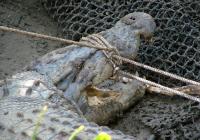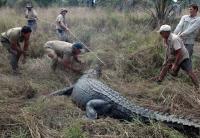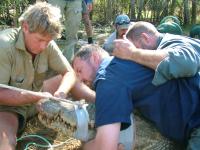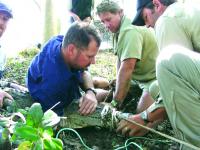
Large estuarine crocodile that is about to be restrained and a tracking device fitted. Three crocodiles relocated from their homes in Far North Queensland have been tracked swimming between 10 and 30 kilometres per day according to a collaborative research project by The University of Queensland, Australia Zoo and Queensland Parks and Wildlife Service.
Professor Craig Franklin, from the University's School of Integrative Biology, said one relocated crocodile swam around the northern tip of Australia to reach home — covering more than 400 kilometres in 20 days.
“We often thought crocodiles tired very quickly but here we show very clearly that they are capable of moving long distances for days on end," Franklin said. 
Steve Irwin and his croc team from Australia Zoo restraining a large male estuarine crocodile.
The results come from the first satellite tracking study of wild crocodiles undertaken by the collaboration and led by Dr Mark Read (QPWS), Professor Franklin and Steve Irwin and funded in part by a generous bequest from the late Charles Tanner, a herpetologist who lived most of his life in Cooktown, and a grant from the Australian Research Council.
The crocodiles were tracked using a specially-designed transmitter attached to the back of their heads that collected the data and relayed it via satellite back to the scientists.
The results highlighted the success of satellite tracking for crocodiles allowing continuous tracking without human interference. 
Steve Irwin and professor Craig Franklin (in blue shirt) on head of a croc.
Professor Franklin said “Satellite technology is a great way of tracking these really cryptic animals which are difficult to follow.
"The success of the study was also recognition of the skills and knowledge that Steve Irwin brought to the project."
He said Steve Irwin was a major driving force behind the study, and his intellectual and logistical support complimented the knowledge, experience and contributions made by the other team members. 
Professor Craig Franklin and Steve Irwin on head of a croc.
"He also gave us the assistance of the croc team from Australia Zoo, who are highly skilled in the capture and care of crocodiles."
All three monitored crocodiles were moved by helicopter between 52 and 130 kilometres away but still found their way back to their capture sites. One crocodile was flown across Cape York Peninsula from the west to east coast, and then circumnavigated the peninsula to return home.
He said crocodiles probably used many factors such as its position to the sun, magnetic fields, sight, and smell to navigate.
“Crocodiles are more closely related to birds than they are any other reptile so they are possibly using navigation systems similar to birds"”
He said the data showed that estuarine crocodiles were oceanic animals which could move phenomenal distances over a prolonged period of time.
He said further satellite and acoustic tracking studies would reveal even more impressive results about crocodile behaviour in coming months and years.
Source : Public Library of Science
 Print Article
Print Article Mail to a Friend
Mail to a Friend
